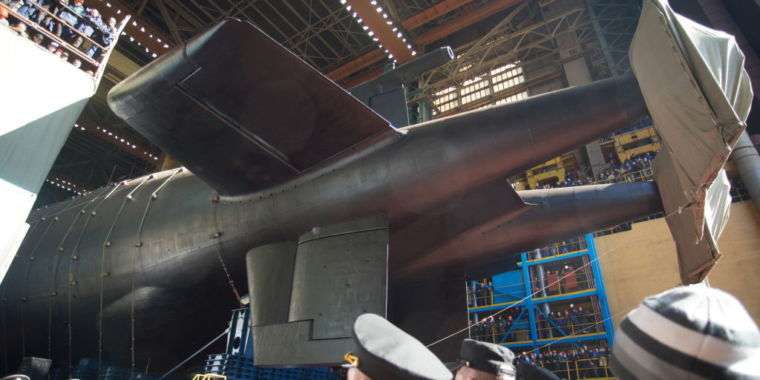
Russia launches sub that will carry doomsday nuke drone torpedo

-
SEVERODVINSK, RUSSIA – APRIL 23, 2019: The Belgorod nuclear-powered submarine (Special Project 09852), during the launching ceremony, that carries Poseidon strategic underwater drones. (Photo by Oleg Kuleshov/TASS via Getty Images)
-
Slide from presentation to Putin in 2015
-
The lower rudders, shown in this MoD. image, are different from those of other Oscar subs. The starboard rudder appears to have some sort of towing or cable deployment gear.Russian Ministry of Defense
-
Bulge in Belgorod’s sternRussian Ministry of Defense
On April 23, 2019, a hulking submarine named the K-139 Belgorod was christened and launched from Severodvinsk, Russia. It slid from Sevmash Shipyard into the Nikolskoye estuary off the White Sea. First laid down in 1992, the Belgorod is the world’s longest submarine, surpassing Russia’s Typhoon-class nuclear-missile sub and the US Navy’s Ohio class. Its construction was paused for over a decade in 2000 after the disaster aboard its immediate predecessor, the Kursk—in which all the crew was lost after an explosion during missile tests. But Belgorod was resurrected with its design modified for a new purpose: carrying the Poseidon nuclear-powered, nuclear-armed torpedo “drone.”
The Belgorod is a modification of the Soviet Navy’s Project 949A design program—what Western military analysts have called the Oscar II class. Originally intended to be a cruise-missile submarine, the Belgorod was re-designated as Special Project 09852, a “special-purpose research and rescue submarine,” in December 2012. The design was lengthened to add a docking compartment for crewed and uncrewed small submersible vehicles, such as submarine rescue vehicles. It was also apparently intended to do cable-laying operations and inspections, deployments of underwater equipment, and other tasks similar to those the US Navy constructed the USS Jimmy Carter for.
The submarine-rescue role was clearly at the front of the mind of the Russian Navy in the years after the Kursk debacle, in which Russia initially refused assistance from the United Kingdom and Norway. The incident was a major embarrassment to Russian President Vladimir Putin, who—just four months into his presidency—was on vacation in Sochi at the time of the accident and remained there for five days afterward.
But the docking bay took on a new role as Putin pushed for development of new nuclear weapons to counter a perceived strategic threat from US anti-ballistic missile deployments. That role was first hinted at when designs for a nuclear-powered, uncrewed nuclear-weapons delivery vehicle were revealed on Russian television in 2015. The Belgorod was one of two submarines shown in a slide revealed in a news report on a briefing of Putin by military chiefs. Then called “Ocean Multipurpose System ‘Status-6,'” the weapon would be officially announced by Putin in March 2018.
With an “intercontinental” range of 10,000 kilometers (more than 6,200 miles) at a top speed of 100 kilometers per hour (60 miles per hour or 54 knots), the weapon now called Poseidon is reportedly capable of carrying a warhead with a yield of at least 10 megatons. That number could possibly be as great as 100, though the payload may vary depending on the type of mission.
Based on the original leaked drawing and analysis of images of tests published by the Russian Ministry of Defense, the Poseidon vehicle measures about 24 meters (just under 80 feet) long and 1.6 meters (5.2 feet) in diameter. The warhead shown in the leaked diagram suggests the warhead is 4 meters (13 feet) long and 1.5 meters (4.9 feet) in diameter—consistent with a large thermonuclear device. The Belgorod will be able to carry four Poseidons and launch them from positions that were used on previous Oscar-class subs for cruise missiles.
The Poseidon isn’t the only special project that the Belgorod will play a part in. Part of the sub’s mission will likely be the deployment of Harmony, a submarine detection sensor network the Russian military is seeking to deploy in the Arctic—similar to the US Navy’s SOSUS sonar network. The Belgorod will be able to ferry sensors out under the ice and deploy mini-subs to put the sensors, powered by undersea nuclear power units, in place.
Joseph Trevithick and Tyler Rogoway of The Warzone have pulled together a fairly thorough analysis of images from the Belgorod‘s April 23 launch published by the Ministry of Defense, Russian media outlets, and Russian naval blogger and TASS contributor Oleg Kuleshov. While the photos are limited—much of the Belgorod was hidden from view during the ceremony—they show some of the unusual differences between this new undersea beast and its predecessors in the Oscar II class.
Like earlier Oscars, Belgorod has twin propellers, but it also has an odd squared-off bulge in its stern that hints at the accommodations made for a docking bay. There is also a noticeable difference in the rudders of the Belgorod. As the International Institute for Strategic Studies’ defense analyst Joseph Dempsey noted in a blog post, the starboard (right) lower rudder’s frame has what might be some sort of towing equipment integrated into it.
‘Belgorod’ twin lower rudders are also squared off – unlike standard Oscar II – with starboard featuring potential towing equipment pic.twitter.com/7YqPKfujYW
— Joseph Dempsey (@JosephHDempsey) April 23, 2019
This could be gear intended to feed out cable used for underwater cable laying or for some sort of towed hardware. Cable-laying seems more likely; its position puts it well below the sub’s rotating screws. But it would still be a dicey place to deploy a towed array when maneuvering—and there’s already a tube for deploying a towed sonar on the top of the sub’s center (upper) rudder, as with other Oscar subs.
Some of the details on the sub spotted by analyst H.I. Sutton suggest that the Belgorod may have other ways of pushing itself around for tight maneuvering. Some hatches on the exposed stern, Sutton posited, were likely for maneuvering jet thrusters. These would be used to turn the sub tightly or keep it in place during precision operations.
Because the remaining two unfinished Project 949A submarines were largely stripped for parts, the Belgorod will remain a one-of-a-kind vessel. But it’s possible that other Oscar-class submarines could be retrofitted to carry the Poseidon.
Listing image by Oleg Kuleshov/TASS via Getty Images




